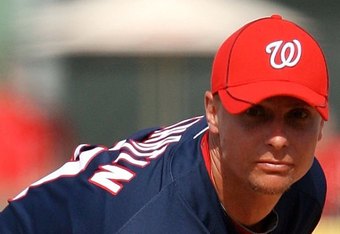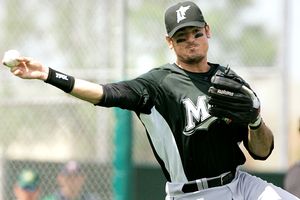 |
| Adam LaRoche: He Just Won't Sign |
I mean, the math isn’t that difficult. The Orioles and Nationals need a first baseman and the only two left are Lee and LaRoche.
And yet the clock continues to tick. Most everyone was in agreement that the two would sign this week but as of yet all remains quiet. So what’s taking so long?
It can’t be about money. Derrek Lee wants $8-10 million, an amount both teams seem willing to pay. And it isn’t about contract length. Lee only wants a one-year deal and Adam LaRoche has already been offered a multi-year contract from the Orioles.
It’s as though both players keep waiting by the phone, hoping that some other team will sweep in the save them from the dire possibility of playing in Washington or Baltimore. But there just isn’t anyone else.
So it looks as though whichever first baseman the Nationals end up with is a player who doesn’t particularly want to be here. So if they don’t want to play in Washington, does Washington really want to watch them play?
General Manager Mike Rizzo all but promised upgrades around the diamond this off season, but other than the punch-in-the-stomach signing of Jayson Werth a month ago, nothing much has happened. Like a line of tumbling dominoes, one player after another either said no to a trade or their employers wouldn’t deal with the Nationals.
So 2011, it would appear, isn’t going to be that turnaround season we had all hoped for. Unless a handful of minor league “inventory” suddenly turns hot, the upcoming season is going to be a bridge to becoming a winning team, not a ladder.
But if a veteran first baseman won’t get the Nationals to the promised land (a .500 season), why not give the local talent one more try before bringing in the hired guns next year? Would it not make more sense to see what guys like Michael Morse can do before relegating them to part-time status?
Two good things are going to happen in 2012. First, many quality free agents will be available next fall. Prince Fielder, Grady Sizemore and Edwin Jackson are just some of the names that could help fill holes on the team’s major league roster.
And second, 2012 will be the first season that the fruit of “The Plan” will begin to make a significant difference for the Nationals.
Here, take a look at which prospects should be available next season:
Chris Marrero
The 21-year-old just completed his fifth professional season and batted .294/.350/.450 for Double-A Harrisburg with 18 home runs and 82 RBI. For his career, the former Florida high schooler has averaged .281-21-91 over a 550 at-bat minor league season.
There is little doubt he won’t succeed against major league pitching. The problem has always been his fielding. Over the last two seasons, Marrero has committed a combined 38 errors.
Marrero was a Jim Bowden pick made during a time when the Nationals didn’t place any great emphasis on athleticism or defense. As a result, his best value will be as a trade-chip to an American League team. There is little doubt that he could excel as a designated hitter.
Stephen Lombardozzi
Lombardozzi is the guy who will make us all forget about Danny Espinosa when he too gets traded in the coming weeks or months. Over his three minor league seasons, Lombardozzi—also 21—has averaged .293/.373/.402 with 29 doubles, 9 triples and 21 stolen bases.
He is a defensive whiz, averaging just eight errors per season. He has a Gold Glove in him just waiting to break out.
Unlike Espinosa, who has more power but a tough time getting on base, Lombardozzi is an ideal leadoff hitter who walks often and steals bases. He is the model of consistency and will be ready for the major leagues sometime late next summer.
Derek Norris
The 21-year-old Norris, who has averaged .261/.414/.462 with 25 homers and 93 RBI over 550 at-bats during his career, will begin his first season in Double-A in 2011 and should be ready for the major leagues by early 2012. Though his defense needs work, coaches and scouts are seeing improvement every season.
My guess is that his bat is so good that the Nationals will ultimately move him to another position to reduce wear-and-tear on his body. And don’t forget, the team already has Wilson Ramos (.278-1-5 in 79 major league at-bats) and Jesus Flores (.260-16-99 over 162 games) ready to share catching duties in 2012 or be used in a trade for pitching.
Bryce Harper
A lot of coaches and scouts think that Harper showed enough in the Arizona Fall League to start for the Nationals in 2012. The 18-year-old batted .343/.410/.629 with a homer and seven RBI in 35 at-bats. A strong season in the minors in 2011 and there is no reason not to believe he’ll be ready.
As a 19-year-old playing in his first year, Ken Griffey Jr. batted .264-16-61 with a .329 on-base percentage. After 200 at-bats over his first two seasons (.224-5-21), Alex Rodriguez hit .358-36-123 as a 20-year-old. I think Harper will be able to hit .275-15-60 in 2012.
Tom Milone
A John Lannan clone but with better control, the 23-year-old lefty has averaged 12-5, 2.88, 9.0/1.6/7.6 over the past two seasons at Class-A Potomac and Double-A Harrisburg. He has “advanced feel” for pitching and is able to hit his spots by changing speeds. For his career, Milone has a 7:1 strikeout to walk ration.
Milone has an average fastball and a plus-change. He added a cutter early in 2009 and since then his stats have gotten better at each level pitched.
At worst, he is another John Lannan, and the Nationals could use another guy like him in the rotation.
Cole Kimball
He was a mediocre starting pitcher for three seasons but became a quality reliever in 2009. Last season, he came out of nowhere to become part of the team’s future. Last season, Kimball pitched for Class-A Potomac and Double-A Harrisburg and went 8-1, 2.17, 5.7/4.5/11.6 and a 4:1 strikeout to walk ratio.
Playing in the Arizona Fall League, he was even better. In 11 games, he crafted a 0.75 ERA with 15 strikeouts and just two walks. Opponents batted just .186 against him.
Though he will spend some time with the Nationals in 2011, he will likely become a mainstay the following season. He has a 96-98 mph fastball and a big frame (6’3”, 240) so he should be able to maintain his power pitch throughout his career.
Sammy Solis
Solis, the Nationals’ second-round pick in last season’s amateur draft, allowed two hits and no walks while striking out three in four innings with Class-A Hagerstown last season. In the Arizona Fall League, Solis went 1-0 with a 3.80 ERA, striking out 12 in 23 innings.
At 6’5,” the lanky lefty has a deceptive motion that causes batters problems. His 92 mph fastball has “plus” movement and his curve has late action—an above average but not great pitch. He is one of those prospects who doesn’t have a really high ceiling but at the same time shouldn’t take too long to reach the major leagues. Most believe that he will be ready by 2012.
Let’s make an educated guess about the 2012 roster and see what it might look like:
Starting Rotation:
1—Stephen Strasburg: A real number-one starter
2—Jordan Zimmermann: Should be a quality number-two for years to come
3—John Lannan: A good number-four but can handle the three spot if he becomes a little more consistent
4—Yunesky Maya or Ross Detwiler: I think Maya can become a solid starter, a guy who can win 12-14 games a season.
5—Tom Milone or Sammy Solis: John Sickels grades Solis a “B” prospect (“prospects have a good chance to enjoy successful careers. Some will develop into stars, some will not. Most end up spending several years in the majors, at the very least in a marginal role”) and requires “minimal” minor league seasoning before making it to Washington.
Without adding a free agent starter, the Nationals have seven quality pitchers for five spots in the rotation. All but one will be under 30 at the start of the 2012 season. That is certainly an above average rotation and the addition of one free agent star could make it second best in the division.
The bullpen could be even better (ages are in parenthesis)
Tyler Clippard (25) 11-8, 3.07, 6.8/4.1/11.1
Drew Storen (22) 4-4, 3.58, 7.8/3.6/8.5
Sean Burnett (27) 1-7, 2.14, 7.4/2.9/8.9
Doug Slaten (30) 4-1, 3.10, 7.5/4.2/8.0
Colin Balester (24) 0-1, 2.57, 6.4/3.7/12.0
Cole Kimball (23) 8-1, 2.17, 5.7/4.5/11.6 (in minor leagues)
Henry Rodriguez (23) 2-0, 4.26, 8.2/4.3/10.5
Talk about a group of power arms! Every one of the players had a strikeout rate above eight per nine-innings.
And by 2012, the everyday positions should look something like this:
C—Wilson Ramos & Jesus Flores: They could combine for .275-15-60 with quality defense
1B—The team has yet to add this player to their roster. Marrero just doesn’t play good enough defense and Tyler Moore (.269-31-111 in Class-A) won’t be ready until 2013 at the earliest.
2B—Stephen Lombardozzi will overtake Daniel Espinosa because he makes contact.
SS—Ian Desmond will have cut down the throwing errors by 2012 and offensively could hit as much as .275-15-75 with stolen bases.
3B—Ryan Zimmmerman should be around for a long time.
LF—Michael Morse is capable of hitting .280-25-85 if given the chance to play every day. 2011 should be the season to give him that chance, to see if he’s an everyday player.
CF—Jayson Werth has played center field before and hopefully he can again, especially if Bryan Harper makes the club in 2012.
RF—Bryan Harper won’t be a slugger in 2012, but he will lay the foundations for the future. Playing solid defense and hitting .270-15-70 will be plenty for the 19-year-old.
It’s becoming obvious that Rizzo won’t be able to change the team overnight like had been hoped; there won’t be any Zach Greinke’s or James Loney’s to be had this off season. And that’s okay. If 2012 is the year of contention, then the Nationals have to find out now if Roger Bernadina, Mike Morse and Nyjer Morgan are starters or utility players.
Once all that gets sorted out, Rizzo can make all the big-time splashy moves he needs to get the Nationals ready for the 2012 season. And I think most of us can live with one more so-so season if it is obvious that respectability is right around the corner.
And I have to believe that it is.





















